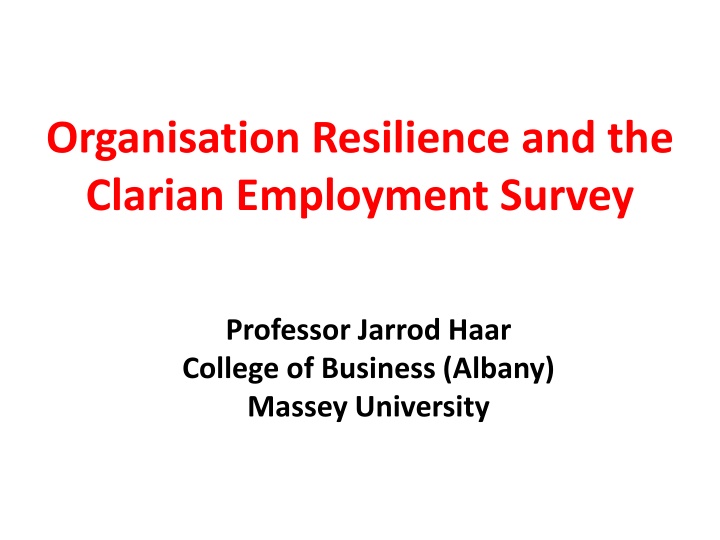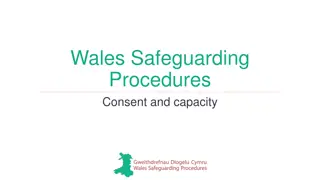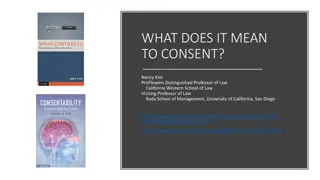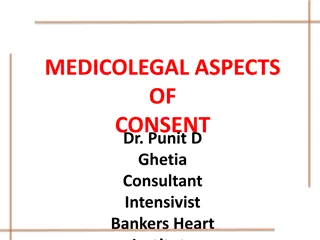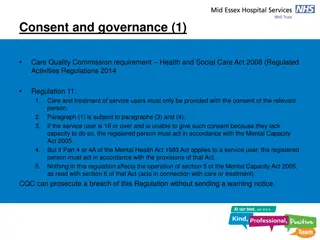Consent in Law
The meaning and importance of consent in legal contexts, this content delves into the nuances of giving and receiving consent. It covers key aspects such as age of consent, statutory rape laws, and the shared responsibility in sexual interactions.
Download Presentation

Please find below an Image/Link to download the presentation.
The content on the website is provided AS IS for your information and personal use only. It may not be sold, licensed, or shared on other websites without obtaining consent from the author.If you encounter any issues during the download, it is possible that the publisher has removed the file from their server.
You are allowed to download the files provided on this website for personal or commercial use, subject to the condition that they are used lawfully. All files are the property of their respective owners.
The content on the website is provided AS IS for your information and personal use only. It may not be sold, licensed, or shared on other websites without obtaining consent from the author.
E N D
Presentation Transcript
Organisation Resilience and the Clarian Employment Survey Professor Jarrod Haar College of Business (Albany) Massey University
Acknowledgements Clare Parkes Our Massey University Team: Professor Jarrod Haar Professor Jane Parker Professor Jim Arrowsmith Dr Bevan Catley Dr Darryl Forsyth
Resilience There are three main resilience discourses: (a) psychological (b) physiological (c) psychophysical More recently (d) organisational This presentation focuses on the psychological resilience literature and how this ultimately shaped our organisational resilience study
Resilience History Resilience research has been undertaken over a number of decades (a) The Berkeley Ego-Resilience Study (Block & Block, 1980) (b) The Menninger Coping Project (Murphy & Moriarty, 1976) (c) The Harvard Preschool Project (White, Kaban, & Attunuci, 1979) (d) The 30-year Kauai longitudinal study conducted by Werner and Smith (1982) Predominately, the literature focuses on children and adolescents
Resilience History More recently, resilience research has moved to focus on employees. Why? Workplace stress Estimated that workplace stress Accounts for 40% of US employee turnover Costs US businesses $50-150 billion per year Costs Australian business $14.8 billion per year Thus (e) The Positive Psychological Capital studies (Luthans and colleagues, 2000s)
Resilience Defined Resilience is defined as toughness, the ability to be adaptable or adjust easily to adversity; to display hardiness and be stress resistant. A person s response to adversity or trauma & bouncing back from difficult experiences. Resilience is not a trait that people either have or do not have. It involves behaviours, thoughts, and actions that can be learned and developed. It develops with time and is used when an individual is confronted with unanticipated situations/events and demonstrates the flexibility to cope
Resilience and Consequences The 30-year Kauai longitudinal study: Kauai Island, Hawaii (Werner & Smith, 1982) found that despite adverse conditions, a resilient attitude transformed people into fully functioning adults Empirical evidence shows that resilience is an important component of a person s wellbeing Resilience is linked positively to: job satisfaction, organizational commitment, psychological well-being, citizenship behaviors, and job performance; and negatively related to: cynicism, turnover intentions, job stress, anxiety and deviant behaviors
Organisational Resilience We extend the psychological resilience to the organisational level, suggesting that organisations that invest in their employees (Strategic HRM approach) may be categorised as having an Organisational Resilience Climate Thus, an organisational culture that seeks to build employees resilience and ability to bounce back from workplace stress and strain We suggest this
Theoretical Model *Work Engagement *Job Satisfaction Job Performance *Turnover Intentions *Happiness Organisational Resilience Climate Leadership Style Org Climates: *Fun *Communication [Convergent Validity] Personality: *Value of Fun at Work [Discriminant Validity]
Method Clarion Survey of New Zealand employees and managers (n=334: 51%/49%) Respondents: married (76%), permanent staff (88%), female (56%), age=31.5 years (21-70yrs) Worked 31 hours/week Org size: <50=31%, 50-200=22%, 201-500=25% Other than Org Resilience, all other measures established and had good reliability [alpha .75- .95] Org Resilience factor analysis reliability = .86
Organisational Resilience Climate My organization Provides training around building staff ability to cope with work stress Provides tools and assistance which help staff get through difficulties at work and outside of work Helps staff to bounce back from small and big workplace changes through clearly explaining the reasoning behind them Strives to provide job security for staff Has managers who regularly monitor and adjust staff workloads to minimize job burnout Cares about the wellbeing of staff
Organisational Resilience Climate Discriminant Validity Attitudes towards fun at work r= -.03, non-sig [note, Fun Workplace Climate is r= .17, p< .01] Convergent Validity Fun Workplace Climate r= .65, p< .01 Communication climate r= .70, p< .01 Additional SEM analysis supports the Org Resilience Climate as being distinct from the other two climates
Organisational Resilience Climate Organisational Resilience Climate correlates significantly with: Leadership Styles (.71, p< .01) Employee Engagement (.55, p< .01) Extra-Role Behaviours (.44, p< .01) Job Satisfaction (.59, p< .01) Org Commitment (.61, p< .01) Turnover Intentions (-.54, p< .01) Org Resilience Mean = 3.1 (SD=.83).
Discussion Overall, we find evidence to support our notion of organisations supporting the resilience (building?) of employees In turn, this was distinct from other forms of organisational climates and was positively related to job outcomes, performance and happiness and negatively linked to turnover Furthermore, leadership styles building on support and participation is likely to be positively related to building such a climate
Limitations & Conclusion A start only Further empirical evidence required especially around whether such a climate enhances employees individual resilience (longitudinal study?) From our study, evidence that Org Resilience Climate is only modest (M=3.1) In conclusion, firms that invest in building the resilience of their staff may gain valuable attitudes and behaviours when compared to competitors (Strategic HRM Advantages)
